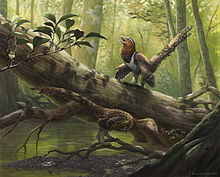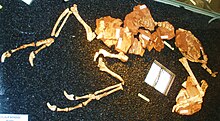Balaur
| Balaur | ||||||||||||
|---|---|---|---|---|---|---|---|---|---|---|---|---|

Drawing skeleton reconstruction of Balaur bondoc . Known skeletal elements in white. |
||||||||||||
| Temporal occurrence | ||||||||||||
| Upper Cretaceous ( Maastrichtian ) | ||||||||||||
| 72 to 66 million years | ||||||||||||
| Locations | ||||||||||||
| Systematics | ||||||||||||
|
||||||||||||
| Scientific name | ||||||||||||
| Balaur | ||||||||||||
| Csiki et al. , 2010 | ||||||||||||
| Art | ||||||||||||
|
||||||||||||
Balaur is a genus of theropod dinosaur from the Late Upper Cretaceous ( Maastrichtian ) of Europe. The onlyspecies described so faris the type species Balaur bondoc ( Rum . = Stocky dragon).
The genus was counted among the Dromaeosauridae by the authors of the first description , but it shows some characteristics that were previously unknown for this group. Fossils of the animal were discovered in Romania and are around 72 to 66 million years old.
Fragmentary remains have been known since 1997; a more complete, but skullless skeleton was only discovered in September 2009 by the geologist Mátyás Vremir and his family. The genus was scientifically described by Csiki and colleagues in 2010 . It is the most complete skeleton of a theropod dinosaur from the European Middle and Upper Cretaceous to date.
features
Balaur was about two meters long. For a dromaeosaurid it was unusually heavy and strong; its skeleton is characterized by numerous fused bones. In addition to the enlarged sickle-like claw on the second toe of the foot, which is characteristic of dromaeosaurids, the Balaur had a second sickle-like claw on the first toe, which could also be spread wide. The hand bones as well as the lower bones of the hind leg were strongly fused. Zoltán Csiki speculates that the fused hand bones could have been too immobile to grasp prey, which is why Balaur would only have hunted with his clawed feet. Also unique for this genus is the strongly rearward-facing pelvis with its enlarged muscle attachment points for the leg muscles.
Systematics
The first bones discovered in 1997 were initially mistaken for the remains of a possible caenagnathid oviraptorosaur . A phylogenetic analysis by Csiki and colleagues comes to the conclusion that Balaur belongs to the Velociraptorinae within the Dromaeosauridae and is there closest related to Velociraptor , whose sister taxon it forms.
In June 2015, a scientific study on a new description of the Balaur fossil was published in which the authors no longer regard Balaur as dromaeosaurids, but as members of the Avialae , a clade to which the birds belong, as well as all theropod dinosaurs that are more closely related to are related to modern birds (Aves) than to the Deinonychosauria . Balaur is therefore closer to the crown group of birds than Archeopteryx , but does not belong to the Pygostylia , but to a paraphyletic group of flightless and long-tailed birds. The basis of this new systematic classification are primarily studies of the bones of the hands and feet, which are much more suited to an omnivorous feeding basal bird than to a purely carnivorous dromaeosaurid.
ecology
Europe was an island archipelago in the Upper Cretaceous. In addition to the Balaur , the dwarf , cattle-sized sauropod Magyarosaurus and the small hadrosaur Telmatosaurus were also found at the site . Balaur was likely able to hunt down prey larger than himself.
Finds

The skeleton discovered in 2009 ( holotype , copy number EME VP.313) was discovered on the Sebeş River 2.5 kilometers north of the city of Sebeş in Romania. The rocks of the site belong lithostratigraphically to the Sebeş Formation , which is dominated by poorly sorted , coarse-grained conglomerates and gravelly sandstones . Below the Sebeş Formation lies the marine Bozeş Formation , above it follows discordant rocks from the Middle Miocene . The site, known as the Sebeş-Glod locality, is in the lower third of the formation - about 100 meters above the boundary with the Bozeş Formation and 450 meters below the Miocene Discordance. The site can probably be assigned to the late early Maastrichtian period. Other fossils of the formation close the mostly very fragmentary remains of other dinosaurs, pterodactyls (Pterosauria), turtles , crocodiles and possibly birds with one.
In contrast to these fragmentary remains, the Balaur individual is a partial skeleton, the bones of which were partially anatomically connected when they were discovered. The Fund consists of eight vertebrae, the sacrum, which consisted of at least four sacral vertebrae, which with the sacrum in the anatomical composite standing pools including incomplete iliac (ilium), pubic bone (pubis) and ischial (ischium), four caudal vertebrae, two fragmentary shoulder blades ( Scapula) with raven bone (coracoid), the complete arms and the lower foot bones, whereby the tibiotarsus, the metatarsal bones and the foot bones of the left foot are preserved in the anatomical union. Skull bones and cervical vertebrae are completely absent. The Balaur individual was probably transported through a river as a partially rotted carcass before its final embedding, after which it was partly in the air for a short time and was partly dismantled.
The second known find, discovered in 1997, comes from the Tuştea-ania locality, about 100 km away, near the village of Tuştea in the Hunedoara district . The remains were discovered during an excavation led by Dan Grigorescu, a professor at the University of Bucharest . The site shows reddish, silty claystones and belongs to the Densuş-Ciula formation , whose sediments were deposited in the Maastrichtian and possibly into the Paleogene . Only the middle layer of this formation contains the fossils of vertebrates; the uppermost part of the layer is dominated by volcanic deposits such as tufa and contains only isolated plant fossils, while the lower part of the layer completely lacks fossils. The deposition area of the fossil-containing layers is interpreted as the lower (distal) part of a flood plain. Among the numerous fossils in the formation are the remains of various dinosaurs, pterosaurs, crocodiles, turtles, frogs and multituber culates . It is best known for its dinosaur nests and eggs as well as newborn fossils, which are attributed to the hadrosaurid Telmatosaurus transsylvanicus .
The Balaur find (copy numbers FGGUB R. 1580–1585) consists of six elements of the left arm, which were found distributed over a relatively small area. Since there are no duplicates among the bones and all bones match in size, it is assumed that they all belonged to the same individual. This individual was about 45% larger than the type specimen.
Initial description
- Zoltán Csiki, Mátyás Vremir, Stephen L. Brusatte, Mark A. Norell : An aberrant island-dwelling theropod dinosaur from the Late Cretaceous of Romania. In: Proceedings of the National Academy of Sciences of the United States of America . Vol. 107, No. 35, 2010, pp. 15357-15361, doi : 10.1073 / pnas.1006970107 .
Individual evidence
- ↑ Stephen L. Brusatte, Mátyás Vremir, Zoltán Csiki-Sava, Alan H. Turner, Akinobu Watanabe, Gregory M. Erickson, Mark A. Norell: The Osteology of Balaur bondoc, an Island-Dwelling Dromaeosaurid (Dinosauria: Theropoda) from the Late Cretaceous of Romania (= Bulletin of the American Museum of Natural History. No. 374, ISSN 0003-0090 ). American Museum of Natural History, New York NY 2013, doi : 10.1206 / 798.1 .
- ^ Zoltan Csiki, Dan Grigorescu: A new theropod from Tustea: are there oviraptorosaurs in the Upper Cretaceous of Europe? In: Current research in vertebrate paleontology. 3rd Annual Meeting of the European Association of Vertebrate Palaeontologists (EAVP) in the Hessisches Landesmuseum Darmstadt, 18th to 23th July 2005 (= Kaupia. Heft 14, ISSN 0941-8482 ). Hessisches Landesmuseum, Darmstadt 2005, p. 78, online (PDF; 4.43 MB) ( Memento of the original from March 4, 2016 in the Internet Archive ) Info: The archive link was inserted automatically and has not yet been checked. Please check the original and archive link according to the instructions and then remove this notice. .
- ↑ Andrea Cau, Tom Brougham & Darren Naish. 2015. The Phylogenetic Affinities of the Bizarre Late Cretaceous Romanian Theropod Balaur bondoc (Dinosauria, Maniraptora): Dromaeosaurid or Flightless Bird? PeerJ . 3: E1032. doi : 10.7717 / peerj.1032
Web links
- American Museum of Natural History (2010, Aug. 30). Stocky dragon dinosaur, relative of Velociraptor, terrorized Late Cretaceous Europe. ScienceDaily
- Scinexx, the knowledge magazine Dinofund: "Squat dragon" hunted with deadly double claw
- The Paleobiology Database Balaur bondoc

